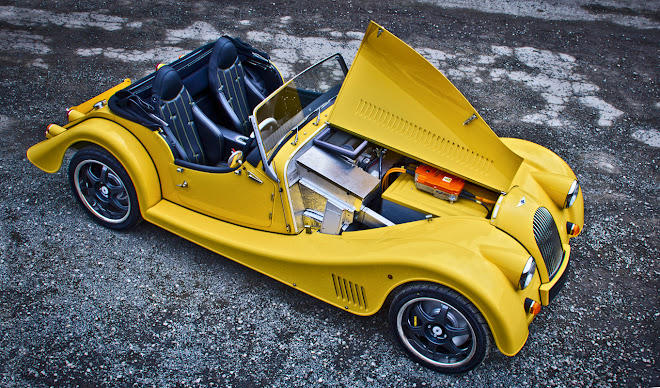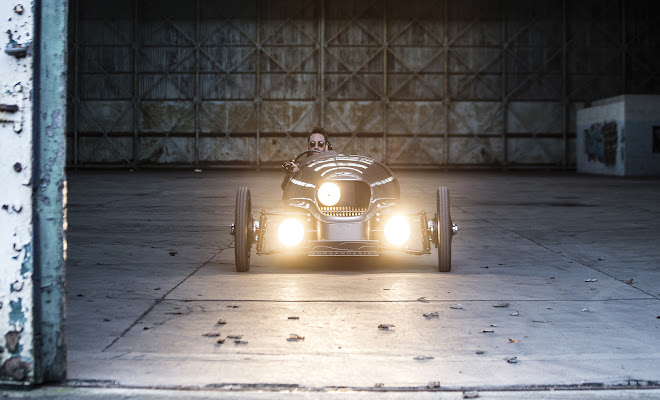by Lem Bingley 
Retro sportscar maker Morgan has been tinkering with alternative powertrains for years, periodically emerging from its shed with a new concoction to see if anyone fancies 21st Century propulsion coupled with 1930s comfort and practicality.
In 2008 Morgan whipped the covers from a fuel-cell concept called LifeCar (below), built in collaboration with Riversimple, among others, and looking like a cross between a traditional Morgan and a Dualit toaster. Alas, it seemed to come to nothing.

In 2011 Morgan showed off the Plus-E, a bright-yellow roadster with a big box of batteries and an electric motor where you might normally find a burbling V8. The Billy Bunter styling disguised a modern alloy chassis, while the unusual EV innards included a full manual gearbox and clutch.
Alas, this experiment also seems to have been wheeled back into a dark corner of the shed, covered with a tarpaulin, and forgotten.

And then in 2015 Morgan revealed the EV3, a battery powered version of its madcap V-twin-powered three-wheeler.

And that notion, finally, has come to something. Earlier this week, at the Geneva Motor Show, Morgan revealed a production-ready version of the same. Which means you’ll be able to buy an EV3 in the final quarter of this year, if you like the notion of an electric car that seems to have driven straight off the pages of a Jules Verne novel.
Styling has changed compared with the earlier EV3 concept, most notably at the front.
Sitting as it does in the motor tricycle category, midway between motorbikes and cars, the EV3 doesn’t legally require two headlamps. So it has just the one, mounted distinctly off-centre, for that eccentric upper-class monocle look. Sensibly, it also features a pair of driving lamps – mounted too low to qualify as actual headlights, so the driver can hope to see where they’re going in the dark.

The nose-cone, which seems to have been inspired by the gigantic 1933 Napier-Railton racing car, features functional brass fins that are part of the battery cooling system. They resemble a row of nicotine-stained robot teeth.
Morgan three-wheelers normally feature a 1.5-litre V-twin engine mounted in the nose, driving the single rear wheel at the back. Connecting the two ends is the clutch and gearbox from an MX-5, a short propshaft running between the seats, a bevel-gear unit just behind the seats, which turns the shaft’s rotation through 90 degrees, and finally a toothed-belt connection to the rear wheel.
The EV3 needs none of the above, instead putting batteries at the front, an electric motor at the back, and cables in between. The precise layout of components – there must be a beefy box of control electronics somewhere, for example – has yet to be revealed. Morgan does, however, say that weight distribution in the EV3 mirrors that of the petrol-powered version, and that overall weight is lower. The electric 3-wheeler is “under 500kg” while the V-twin edition weighs 525kg dry. The lithe weight is quite an achievement for an electric vehicle, helped by fashioning the bonnet, side pods and tonneau from high-tech carbon fibre

Remaining bodywork is aluminium over a traditional wooden frame. The body panels are assembled separately into a sort of inverted bathtub, before being slipped snugly over the 3-wheeler’s underlying tubular steel skeleton like a cosy over a teapot.
The EV3’s lithium-ion cells will hold 20kWh of electrical energy, a little less than the 22kWh battery you’d find in a standard BMW i3 electric car. Morgan claims a range of 150 miles between charges, much more than the BMW’s 80-odd miles, which may well be feasible given the EV3 is much smaller, has wheels that belong on a bicycle, and weighs less than half as much as an i3. Practical range will, of course, depend on how the 3-wheeler is driven, with a mashed accelerator tending to knobble range.

If you do stamp on the pedal, zero to 62mph will take less than 9 seconds in the EV3 – not as quick as the petrol 3-wheeler’s 6-second dash. The liquid cooled electric motor is rated at 46kW (62bhp) compared with the V-twin’s 82bhp. Flat out in the EV3 will be “in excess of 90mph”, Morgan says.
A full charge from a standard socket is likely to take about seven hours, or a bit less from a higher-current wallbox. It remains to be seen if the EV3 will be compatible with more rapid chargers.

Remaining charge and other electrical info is displayed on a circular digital screen, mounted ahead of the driver and styled to blend in with the pre-war look of the speedo, brass-backed gear selector and toggle switchgear.
Happily, most of the usual brickbats hurled at electric cars won’t apply to the EV3. Nobody will complain about range, since you’d have to be mad to drive to St Tropez and back in a car with no luggage space and no windscreen.
Actually, scratch that. You’d have to be mad to think the EV3 offers a sensible means to get from any kind of A to any sort of B. Perhaps that’s what makes it so enticing.
Morgan EV3: yesterday’s future
6 March 2016
Read more about: electric cars Morgan Riversimple small cars



